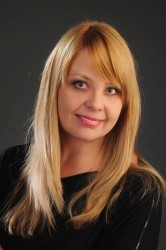
Anita Lorenc
Institute of Applied Polish Studies
University of Warsaw
anita.lorenc@uw.edu.pl

|
Anita Lorenc Institute of Applied Polish Studies University of Warsaw anita.lorenc@uw.edu.pl |
| Participants: | 20 |
| Type of Study: | elicited |
| Location: | Kalisz, Poland |
| Media type: | audio |
| DOI |
The audio files are available via The Language Archive at the Max Planck Institute for Psycholinguistics in Nijmegen. Users need to register and request permission to get access to the files.
Three ZIP files for the materials are available here.
The handle for the entire collection is here.
Trochymiuk A., 2008, Wymowa dzieci niesłyszących. Analiza audytywna i akustyczna (Eng. Pronunciation of hearing-impaired children. Auditive and acoustic analysis) (seria „Komunikacja Językowa i Jej Zaburzenia”, vol. 22), Lublin: Wydawnictwo UMCS
Trochymiuk A., 2007, VOT and durational properties of selected segments in the speech of deaf and normally hearing children, „Studia Phonetica Posnaniensia”, vol. 8, p. 111–142..
Trochymiuk A., 2005, Realization of the voiced-voiceless contrast by hearing impaired children, „Studia Phonetica Posnaniensia”, vol. 7, p. 75–96.
Trochymiuk A., 2003, Voiced Realisations of Plosives in Word Initial Position by Hearing Impaired Children. Acoustic Phonetics Analysis [in:] Böttger K., Dönninghaus S., Marzari R. (ed.), „Die Welt der Slaven”, Band 16, Beiträge der Europäischen Slavistischen Linguistic, Band 6, München, p. 111–123.
In accordance with TalkBank rules, any use of data from this corpus must be accompanied by at least one of the above references.
The project consisted in recording utterance of hearing-impaired children participating in two types of tasks:
| Annotation format | orthographic transcripts of the utterances in TX format (prompts) |
| Type of speech | elicited utterances of isolated words |
| Speakers' age | 8-12 years |
| Type of hearing loss | sensorineural |
| Degree of hearing loss | profound (18 children) and severe (2) |
| The moment of hearing loss | prelingual |
| Reason of hearing loss | genetic (4), rubella (3), damages (3), reason unknown (10) |
| Hearing support device used | hearing aid |
| The moment of receiving the hearing aid | In most cases between 3-5 years of age |
| Evaluation of speech intelligibility | 24,7% |
| The presence of other disorders | none |
| Duration of applying the Cued Speech method | 3 years minimum |
| The beginning of speech therapy | In most cases: between 3 and 6 years of age |
| Linguistic Education / Rehabilitation Method | Polish adaptation of the Cued Speech method (fonogesty) |
| Number of children | 20 (11 girls and 9 boys) |
| Name | Sex | Type of task realized |
|---|---|---|
| AdDu | f | gol;opoz;wyr |
| AdKu | m | gol;opoz;unknown;wyr |
| AlJo | f | gol;opoz;wyr |
| AnKo | f | gol;opoz;wyr |
| AnKs | f | gol;opoz;wyr |
| DaLi | m | gol;opoz;unknown;wyr |
| DaSz | m | gol;opoz;wyr |
| EwWi | f | gol;opoz;unknown;wyr |
| KaMi | m | gol;opoz;wyr |
| KaPu | f | gol;opoz;wyr |
| KrGr | m | gol;opoz;wyr |
| MaSi | f | gol;opoz;wyr |
| MaSm | f | gol;opoz;wyr |
| PaMi | f | gol;opoz;wyr |
| PaOs | f | gol;opoz;wyr |
| PaPr | f | gol;opoz;unknown;wyr |
| RaMr | m | gol;opoz;unknown;wyr |
| ToWe | m | gol;opoz;wyr |
| ToWl | m | gol;opoz;wyr |
| ToWo | m | opoz;wyr |